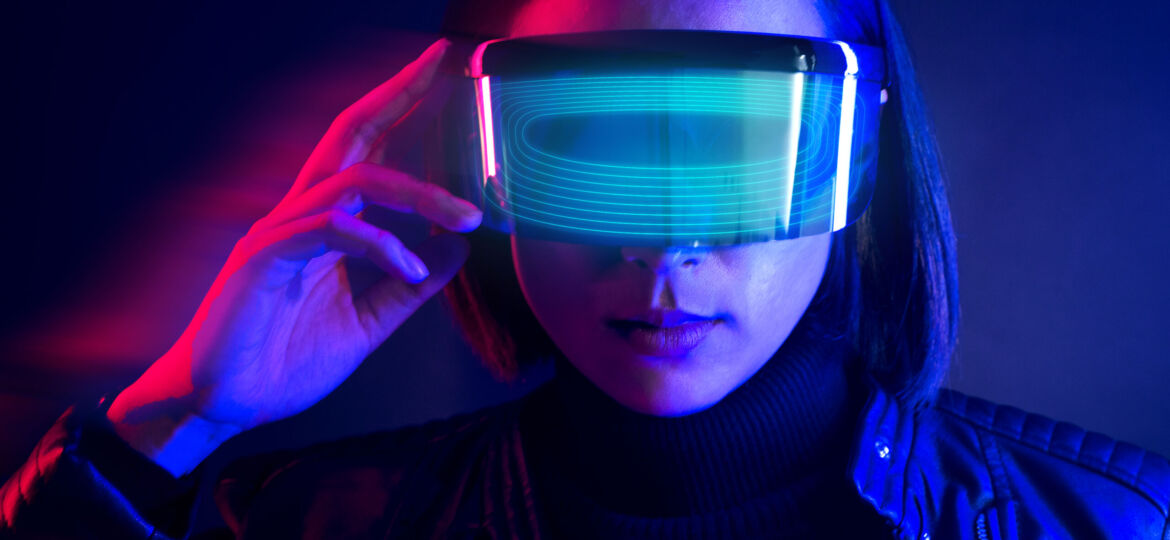
When we talk about the future of technology, augmented reality (AR) cannot be left out of this conversation.
AR is being allied to several areas, making the productive and creative process more agile and innovative. In addition, design is increasingly associated with this technology, contributing to its better performance.
In this article, you will see what augmented reality is, how it works, what its uses are today and what to expect from it in the future!
Ready? So let’s dive into that reality!
What is augmented reality?
The term augmented reality was coined in 1990 by Thomas Caudell, a Boeing computer services researcher to describe how the head-mounted displays that electricians use when assembling complicated wiring harnesses worked.
Furthermore, in 1998, one of the first commercial applications of the technology was used in the yellow first down marker that began appearing in televised football games.
But what is augmented reality really?
AR is the integration of digital information with the reality that surrounds us in real time. In other words, this technology uses three-dimensional models and scenarios to virtually complement the scenario around us.
Also, augmented reality uses sounds, smells and other sensory elements to make the experience even more immersive. Nowadays, apps like google glass and pokémon go are examples of this system.
How does augmented reality work?
First of all, AR needs an intermediary that will connect the user in the real world to layers of virtual information superimposed by reality. Nowadays, this is done by special glasses, tablets and even smartphones. Contact lenses are also being developed to contribute to augmented reality.
An example of the use of AR by smartphones is GPS. They use the car’s real-time location to set the correct orientation to a specific destination based on real-time.
For this to occur, developers must produce the animations and information in an augmented reality creator in the real world. In this way, the augmented reality equipment will translate the digital information, executing the code and recreating the image correctly.
To top it off, there are certain advanced AR equipment, mostly in military training, that use gesture recognition, objective recognition, and machine vision.
What is the difference between VR or AR?
Many people can get confused between the meanings and functionalities of augmented reality and virtual reality.
After all, what is the difference between the two?
Augmented reality, as we have seen, is an extension of reality through digital information. Therefore, we continue to witness the space around us in real time, but with virtual complements that make the experience more immersive.
Virtual reality, on the other hand, is a scenario totally disconnected from real-time reality. In other words, a new place is built, digitally, so that we can live experiences out of reality. In this case, it is as if you were using a device to leave your office and enter another room, virtually designed and detached from your office.
Also, if you want to know more about how virtual reality works, click here and check out this article that we made explaining this concept in detail.
At the end of the day, augmented reality necessarily depends on its surroundings to work. Virtual reality, on the other hand, is a “universe” apart from reality, not necessarily depending on its surroundings.
Uses of augmented reality
Check out now some ways to use augmented reality in everyday life and in specific areas.
- Retail. Consumers can use the store’s online app to see how products will look in their own homes before buying.
- Entertainment. AR can be used to overlay a virtual game in the real world or enable users to animate their faces in different and creative ways on social media.
- navigation. AR can be used to overlay a route to the user’s destination over a live view of a road.
- Tools and measurement. Mobile devices can use AR to measure different 3D points in the user’s environment.
- Architecture. AR can help architects visualize the building project.
- Military. Data can be displayed on a vehicle’s windshield that indicates destination directions, distances, weather and road conditions.
- Archeology. AR has aided archaeological research by helping archeologists reconstruct sites.
Examples of AR
Check out now some real examples of the use of augmented reality.
- Apple Measure app. The Apple Measure app acts like a tape measure by enabling users to select two or more points in their environment and measure the distance between them.
- Snapchat. Snapchat filters use AR to overlay a filter or mask over the user’s Snap or picture.
- Pokemon Go. Pokemon Go uses the player’s GPS to detect where Pokemon creatures appear in the user’s surrounding environment for them to catch.
- Google Glass. This small wearable computer enables users to work hands-free.
What to expect for the future?
We can expect augmented reality to continue to become popular in the future. Apps like Pokémon Go and Apple Measure are examples of this.
In addition, large companies such as Google, Meta and Apple are working so that this technology can be further improved. Design will also be an important part of the process. After all, visual elements will make the user experience more and more immersive and realistic. Also, with the coming of 5G, AR programs will be able to work more easily.
Now, if you liked the content of this article, take the opportunity to check out other texts on FF Design’s Blog with similar themes. We are waiting for you there!
